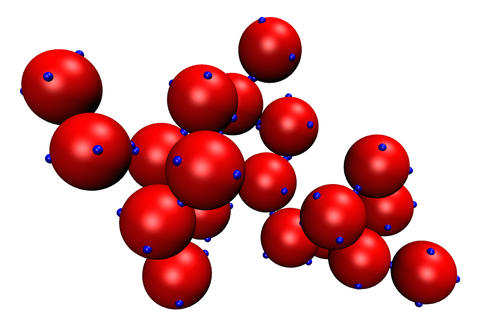
Model "patchy" particles self-assemble and provide guidance for understanding the nature of self-assembly in more complicated systems such as protein solutions.
Nature’s toolkit includes its still-matchless ability to effortlessly assemble proteins, membranes and other complex structures from parts lists of atoms, molecules and particles of various sizes and shapes. Researchers have worked for several decades to understand the mechanisms behind this almost magic-like construction process.
New research, published by scientists at the National Institute of Standards and Technology (NIST) and a colleague, moves researchers a big step toward the aim of devising comprehensive theories and realistic models of self-assembly. The advances provide insights to guide efforts to harness and manage self-assembly in artificial materials and reliably make structures as designed. These could include entirely new structures composed of subunits specially tailored to self-assemble in predictable ways. Similarly, the work could help prevent unwanted structures from forming, a concern especially during the production of biopharmaceuticals.
Debra Audus, a NIST materials scientist, and two colleagues have come up with a new approach for predicting the clustering behavior of particles in fluids, an environment in which self-assembly frequently occurs. They describe their theoretical framework in a recent issue of the Journal of Chemical Physics.
Applying the framework to experimental results, other researchers can cut to the chase more quickly and predict the shape, size and distribution of particle clusters as conditions change in liquid mixtures.
Audus, NIST materials scientist Jack Douglas and Francis Starr of Wesleyan University in Connecticut added another layer of realism to a so-called patchy particle model, a popular tool for investigating how particles interact in liquids. These models are simplified representations that show how inter-particle forces steer self-assembly processes. They can streamline efforts to identify the basic principles at work, saving researchers from having to piece them together through trial-and-error experiments.
Typically, patchy particles are spheres whose surfaces are precisely “decorated” with several patches—each possessing a directional attractive force, or bond. Usually, the models stop there, but the team went one better. They cloaked their five-patch particles with a pervasive, uniform force—akin to the ubiquitous van der Waals forces arising from molecular interactions. Though feeble, these attractive forces exert significant influence on the ultimate shape of multi-particle structures.
Including both types of forces in the model set the stage for a dynamic competition that defined where cluster formation and self-assembly occur, Audus explained.
Changing the size of the particle-encompassing attractive force significantly altered how particles were distributed into areas of low and high concentration, also known as phases. As the uniform force increased, the temperature at which particles began to separate also increased, and the region where self-assembly took place decreased. These relationships were revealed through a computer-intensive simulation method used to explore the behavior of complex and often disordered systems through repeated random sampling. Crunching numbers to measure the behavior of some particles as they separated into phases engaged multiple computers for nearly a month—testimony to the bewildering intricacies of self-assembly.
From there, the team used a theory-guided approach to distill the simulation results and look for overarching lessons-learned that other researchers can apply. For one, they determined that their five-patch particles behaved like swollen, branched polymers, a well-studied class of materials. The researchers also identified the thermodynamic conditions under which self-assembly behavior will emerge, and they describe methods for determining the average molecular weight of clusters and their size distribution.
Employing these methods, other researchers can probe the behavior of particles in solution by measuring how they scatter light, for example, and compare their results to patchy particle models. For instance, do the experimental particles behave like theoretical particles with five patches, rather than seven?
“From there, researchers can use theory to predict how particles in their mixtures will cluster under different conditions,” Audus explained. “With our framework, they can gain insights into clustering phenomena.”
D.J. Audus, F.W. Starr, and J.F. Douglas, “Coupling of isotropic and directional interactions and its effect on phase separation and self-assembly.” Journal of Chemical Physics, 144, 074901 (2016); http://dx.doi.org/10.1063/1.4941454.

